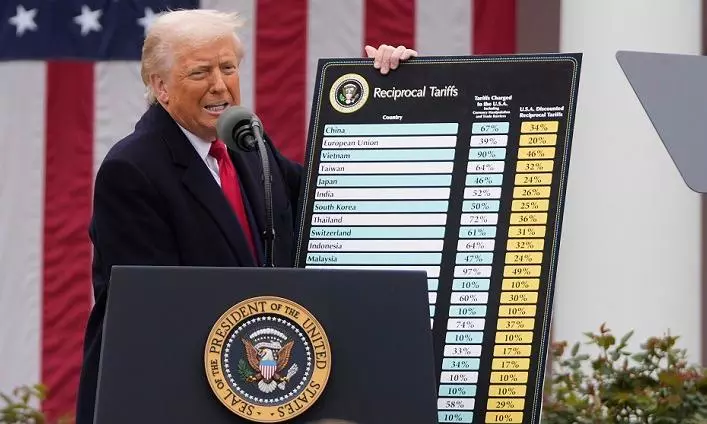
- Home
- India
- World
- Premium
- THE FEDERAL SPECIAL
- Analysis
- States
- Perspective
- Videos
- Sports
- Education
- Entertainment
- Elections
- Features
- Health
- Business
- Series
- In memoriam: Sheikh Mujibur Rahman
- Bishnoi's Men
- NEET TANGLE
- Economy Series
- Earth Day
- Kashmir’s Frozen Turbulence
- India@75
- The legend of Ramjanmabhoomi
- Liberalisation@30
- How to tame a dragon
- Celebrating biodiversity
- Farm Matters
- 50 days of solitude
- Bringing Migrants Home
- Budget 2020
- Jharkhand Votes
- The Federal Investigates
- The Federal Impact
- Vanishing Sand
- Gandhi @ 150
- Andhra Today
- Field report
- Operation Gulmarg
- Pandemic @1 Mn in India
- The Federal Year-End
- The Zero Year
- Science
- Brand studio
- Newsletter
- Elections 2024
- Events
- Home
- IndiaIndia
- World
- Analysis
- StatesStates
- PerspectivePerspective
- VideosVideos
- Sports
- Education
- Entertainment
- ElectionsElections
- Features
- Health
- BusinessBusiness
- Premium
- Loading...
Premium - Events

Changes in America’s economic structure, coupled with its global dominance in the services sector, explain why manufacturing now occupies only a modest share of the nation’s GDP
The latest installment of the Make-America-Great-Again (MAGA) assault on globalised economic growth takes the form of an import duty of 100% on a segment of pharmaceuticals.
Also read | Build in America or pay: Trump tariff threat rattles Indian drugmakers
Pharmaceuticals are a key sector of exports from India to the US. The duty applies to patented and branded drugs. India mostly exports generic drugs to the US. But even generics tend to have brand names: for example, the generic drug paracetamol might be sold as Crocin or as Dolo. Whether off-patent paracetamol would attract 100% import duty in the US because it carries a brand on its blister pack remains to be seen.
India's pharma exports on edge
The pharma industry is worried on two fronts: inconsistent classification, where one customs officer may treat Crocin as a branded drug while another calls it an off-patent generic, and the likely higher reliance of American consumers on generics as patented drugs become costlier, which could trigger a tougher crackdown on generic imports as well. From the way it cut the budget allocation for healthcare in the “One Big Beautiful Bill” (if the name sounds idiotic, just remember its lineage), the Trump administration would appear to have no qualms about raising the cost of drugs for the American people.
The Trumpian dream of making America a great manufacturing nation again by shutting out lower-cost imports to the US is wishful thinking of the kind that even juveniles would sneer at. It would end up hurting Americans and fail to significantly increase the share of manufacturing in US economic output.
The share of manufacturing in the US GDP is 10%, and the share of manufacturing jobs in total employment, 9%. The world average share of manufacturing in GDP has been steadily falling, as economies prosper and start generating more and more of the services that more complex economies call for. It has come down from 19% in 1997 to 15%. India and Pakistan are united not only by a lack of civility on the playing field, but by the same share of 13% as their manufacturing share in GDP.
Manufacturing shrinks, services surge
The share of manufacturing in GDP is 9% for Canada, Britain and France as well. Whatever Trump might think, not one of these is a poor, third-world economy. Manufacturing’s share is high in some high-income countries, though: 17% in Denmark, 18% in Ireland and Germany, and 21% in Japan.
Does this mean that US manufacturing is small compared to that of Germany or Japan, taking into account only the larger of these economies with a high manufacturing/GDP share? Far from it. The US is the world’s largest economy, by far, at $29,185 billion. The manufacturing output for either Germany ($839 billion) or Japan ($845 billion) accounts for less than 30% of the total US manufacturing output of $2,918.5 billion.
Why does manufacturing look like a shrivelled version of its former self to most Americans? This is because the service industries have grown by leaps and bounds, leaving manufacturing far behind. The US service industries dominate the world, in information technology, finance, retail trade, scientific research, healthcare, selling college education to foreigners, restaurants, entertainment, including television and book publishing. The US would actually struggle to fill manufacturing job vacancies, if they do arise, as Taiwan Semiconductor Manufacturing Company has been finding out at its new Arizona plant.
That plant came up not because of Trump tariffs, but as a result of the Biden administration’s industrial policy, articulated in laws such as the Infrastructure Act, the Chips Act and the Inflation Reduction Act. The names of these laws are deceptive. These laws are meant to finance directly, as well as incentivise large-scale private investment, in American capacity in new industrial segments such as advanced semiconductor manufacture, the green energy transition, including electric vehicles, carbon capture and new fuels like green hydrogen.
Democrats miss voter angst
If the Biden administration had shown a fraction of the marketing imagination deployed in India for government schemes, whether of the central government or of state governments run by the Opposition, Biden would not have been dismissed by the American public as a failure who could not check either rising prices or immigrants flooding across the US-Mexico border.
Also read | Trump signs order granting tariff exemptions on several goods to ‘aligned partners’
Biden’s performance on immigration control was better than people generally believed, and he failed to get key legislation on immigration through because Trump asked Republican legislators to block bills that they agreed with wholly in principle.
But why did so many Americans back Trump? What is their angst that the Democrats failed to understand?
Trump is the wrong answer to a genuine problem. America is rife with inequality, sinking affordability of housing, and rising nervousness about job prospects, even after obtaining a college education and running up a huge burden of student loans. Social media amplifies every incipient neurosis, conspiratorial diagnosis and simplistic solution.
Two economies, one nation
The per capita income in the US is $89,000. The median income, however, is less than $40,000. The per capita income is obtained by dividing the total income of every resident by the total population. It gives a simple average. The median measures something else. If you list the entire population by income in an ascending or descending order, and choose the midpoint, so that half the population is on one side and the other half on the other, the income at the midpoint is the median income.
In a country with high income inequality, like the US, with the world’s largest share of billionaires living out the high life, the average income would be very high, but it does not really represent the income of the average Joe or Jane. The median is not affected by extremes of income and poverty. It typifies the average Joe and Jane.
The rich world, in general, has a more equitable distribution of income than the poor world. The US is far better off than, say, South Africa. Yet, the income inequality in the US is far worse than in the rest of the rich world. There are all other kinds of social dysfunction associated with this, spanning racism, police conduct, drug use, family stability, the proportion of the young who have the benefit of growing up with both biological parents who shower affection and attention on their offspring, ghettoization and gentrification of and within towns, access to quality schooling and so on.
Insulating India from US populism
Globalisation helped the rich grow fabulously rich. Those who watched manufacturing jobs migrate to China and other parts of Asia, and a chunk of office jobs get taken over by technology or outsourced to India, felt cheated.Also read | Trump’s tariffs on India spare Russia ties for now, but threaten exports
The US government raises the least amount of taxes as a proportion of GDP and spends the least as a proportion of GDP in the rich world. Instead of taxing the rich and using the money to improve the lives of those forced to adapt to the changes wrought by globalisation, the American political system has degenerated into something in which Trump and his simplistic slogans actually get him elected.
India cannot export better politics to the US – it has little good politics to spare and Americans cannot really import governance from outside the country. India can only protect itself when populist politics in the US run riot, damaging lives around the world. Our politicians should focus on that. The challenge is a little more complex than finessing the strength and intimacy of the embrace between leaders.
(The Federal seeks to present views and opinions from all sides of the spectrum. The information, ideas or opinions in the articles are of the author and do not necessarily reflect the views of The Federal.)


